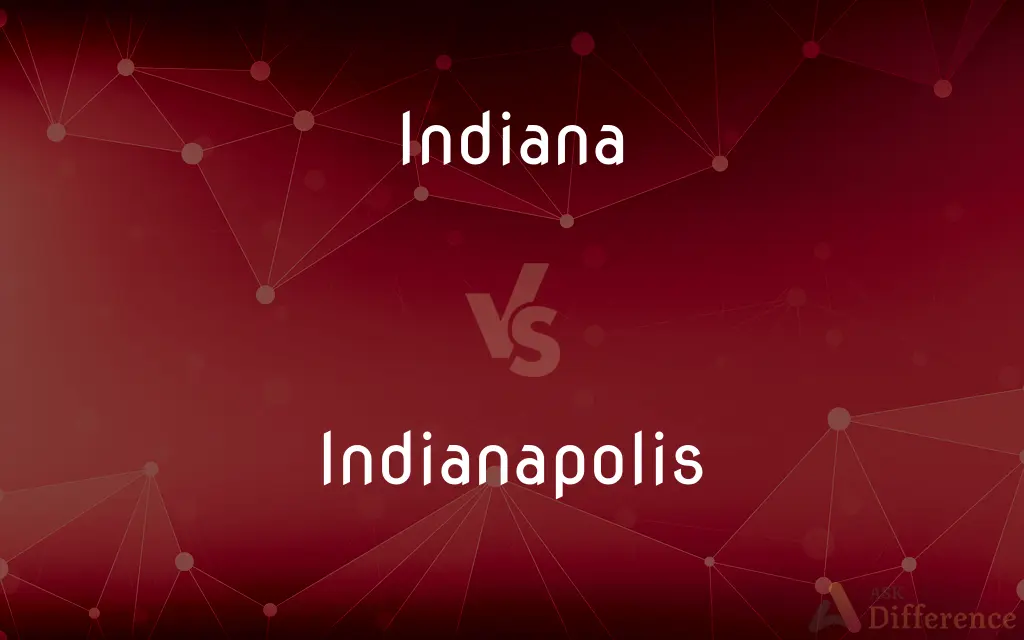Indiana vs. Indianapolis — What's the Difference?
Edited by Tayyaba Rehman — By Urooj Arif — Updated on May 9, 2024
Indiana is a U.S. state known for its diverse economy and agriculture, while Indianapolis, its capital, is famous for cultural institutions and sports events.

Difference Between Indiana and Indianapolis
Table of Contents
ADVERTISEMENT
Key Differences
Indiana is a Midwestern state with a broad economic base spanning manufacturing, agriculture, and technology. On the other hand, Indianapolis, as the state capital, focuses more on service industries and is a major hub for sports and conventions.
Indiana offers a variety of natural landscapes, including farmlands, forests, and lakes, which attract outdoor enthusiasts. Whereas, Indianapolis is renowned for its urban architecture, including the iconic Indianapolis Motor Speedway and the Children’s Museum of Indianapolis.
The state of Indiana has a wide-reaching cultural heritage influenced by both the Midwest and the South, which is reflected in its cuisine and festivals. Indianapolis, however, is noted for a vibrant arts scene, hosting numerous cultural festivals and events like the Indy Jazz Fest.
Indiana’s education system includes several nationally recognized universities and liberal arts colleges spread across the state. In contrast, Indianapolis is home to major educational institutions like Indiana University-Purdue University Indianapolis (IUPUI) and Butler University, offering focused urban educational opportunities.
Regarding governance, Indiana operates under a state government structure with elected officials managing statewide issues. Meanwhile, Indianapolis functions under a consolidated city-county government known as Unigov, which is unique in the state.
ADVERTISEMENT
Comparison Chart
Geographic Scope
Statewide, diverse landscapes
City limits, urban setting
Economy
Mixed economy, including agriculture
Predominantly service-oriented
Cultural Significance
Broad cultural influences
Focused cultural institutions
Key Attractions
State parks, historic sites
Indianapolis Motor Speedway, museums
Government Structure
State government
Consolidated city-county government
Compare with Definitions
Indiana
Known for the Indianapolis 500 auto race.
Indiana attracts hundreds of thousands to the Indianapolis 500 every May.
Indianapolis
The capital city of Indiana and its largest city.
Indianapolis plays a central role in the governance and culture of Indiana.
Indiana
A U.S. state in the Midwest known for its diverse economy.
Indiana's economy benefits significantly from both manufacturing and agriculture.
Indianapolis
Features a consolidated city-county government known as Unigov.
Indianapolis has a unique administrative structure that merges city and county governments.
Indiana
Characterized by a mix of urban and rural areas.
Indiana's landscape transitions from bustling cities to quiet rural communities.
Indianapolis
A hub for higher education and healthcare.
Indianapolis is home to major universities and healthcare facilities.
Indiana
Has a significant agricultural sector.
Corn and soybeans are major components of Indiana's agricultural output.
Indianapolis
Famous for the Indianapolis Motor Speedway.
The city is synonymous with the Indianapolis 500, a major annual racing event.
Indiana
Experiences a continental climate, with cold winters and hot summers.
Indiana residents experience a wide range of weather conditions throughout the year.
Indianapolis
Hosts significant cultural and sports events.
Indianapolis is bustling with activities ranging from sports to conventions.
Indiana
Indiana ( (listen)) is a U.S. state in the Midwestern United States. It is the 38th-largest by area and the 17th-most populous of the 50 United States.
Indianapolis
Indianapolis (), colloquially known as Indy, is the state capital and most-populous city of the U.S. state of Indiana and the seat of Marion County. According to 2019 estimates from the U.S. Census Bureau, the consolidated population of Indianapolis and Marion County was 886,220.
Indiana
A state in midwestern United States
Indianapolis
The capital and largest city of Indiana; a major commerical center in the country's heartland; site of an annual 500-mile automobile race
Common Curiosities
Are there any natural attractions in Indiana outside of Indianapolis?
Yes, Indiana is home to several state parks and natural reserves like Brown County State Park and the Indiana Dunes National Park.
How does the economy of Indianapolis differ from that of Indiana?
Indianapolis has a predominantly service-based economy, focusing on healthcare, finance, and education, while Indiana has a more diversified economy that includes significant manufacturing and agricultural sectors.
What are major cultural events in Indianapolis?
Major events include the Indianapolis 500, Indy Jazz Fest, and numerous art exhibitions.
What historical sites can be found in Indiana?
Indiana is home to several historical sites like the Angel Mounds State Historic Site and the historic town of New Harmony.
Does Indianapolis have any unique architectural features?
Yes, the city features notable architectural pieces like the Indiana State Capitol and several modern skyscrapers.
What is the capital of Indiana?
Indianapolis is the capital city of Indiana.
What role does agriculture play in Indiana's economy?
Agriculture is a significant sector in Indiana’s economy, especially in rural areas outside of Indianapolis.
Is Indianapolis important for Indiana's economy?
Yes, as the state capital and largest city, Indianapolis plays a crucial role in the economic framework of Indiana.
What is the population difference between Indiana and Indianapolis?
Indiana has a population of about 6.7 million, while Indianapolis has a population of approximately 877,000.
What types of government does Indiana have?
Indiana has a state government, while Indianapolis operates under a consolidated city-county government known as Unigov.
How does the climate in Indianapolis compare with the rest of Indiana?
The climate in Indianapolis is typical of Indiana, with hot summers, cold winters, and moderate precipitation throughout the year.
How does transportation in Indianapolis compare with the rest of Indiana?
Indianapolis has a more developed public transportation system, including buses and a bikeshare program, compared to the more car-dependent rural areas of Indiana.
What educational opportunities are available in Indianapolis?
Indianapolis offers numerous educational opportunities through institutions like IUPUI, Butler University, and the University of Indianapolis.
How does the cultural diversity in Indianapolis compare with Indiana as a whole?
Indianapolis typically exhibits more cultural diversity due to its larger population and status as an urban center.
What are the major industries in Indianapolis?
Major industries in Indianapolis include healthcare, education, finance, and insurance, alongside hosting major sports events and conventions.
Share Your Discovery

Previous Comparison
Libertarian vs. Libertine
Next Comparison
Mass vs. MessAuthor Spotlight
Written by
Urooj ArifUrooj is a skilled content writer at Ask Difference, known for her exceptional ability to simplify complex topics into engaging and informative content. With a passion for research and a flair for clear, concise writing, she consistently delivers articles that resonate with our diverse audience.
Edited by
Tayyaba RehmanTayyaba Rehman is a distinguished writer, currently serving as a primary contributor to askdifference.com. As a researcher in semantics and etymology, Tayyaba's passion for the complexity of languages and their distinctions has found a perfect home on the platform. Tayyaba delves into the intricacies of language, distinguishing between commonly confused words and phrases, thereby providing clarity for readers worldwide.












































